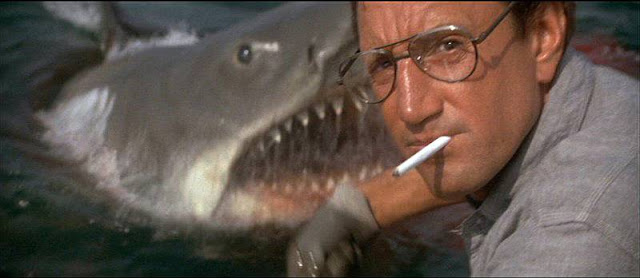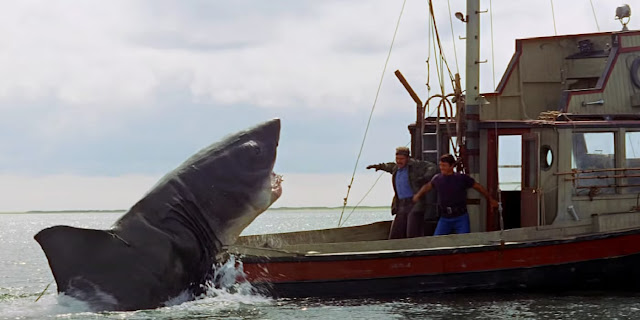Jaws is often cited as the film that changed the landscape of cinemas, altering the mindset of film studios away from classic Hollywood release strategies to simply chasing after the next summer blockbuster. Released in the summer of 1975 on a budget of just $9 million it took everyone by storm and earned nearly $500 million worldwide, making it one of the most profitable films in history. The studios took notice and have been chasing that high ever since. Based on Peter Benchley’s 1974 pulp novel of the same name, Jaws seemed destined to be just another schlocky creature feature, this time with a giant shark as the monster of the week, but director Steven Spielberg, fresh off the set of his successful, but hardly groundbreaking, crime drama The Sugarland Express, had grander ideas than just a genre picture. What ended up on screen far surpassed the prose of Peter Benchley and became the type of film that defined the genre for decades to come. Nearly fifty years later it continues to scare audiences and most movie goers have either seen it or, at the very least, are familiar with it.
Amity Island is a tourist spot during the summer months both for the charming community and the glorious beaches. In fact the town is dependent on those tourist dollars to get them through the off season. Should those dollars not roll in many residents would have to close up shop and move away. One summer evening a young woman attending a beach party goes for a swim off the shores of Amity and is attacked by an unseen force. The following morning her remains, what little there is left, are found washed up on the shore. A medical examiner determines that her death was the result of a shark attack. Newly hired police chief Martin Brody (Roy Scheider) immediately closes the beaches but is quickly strong-armed by the Mayor, Larry Vaughn (Murray Hamilton), into reopening them. The mayor sees closing the beaches as a death knell for the town with the upcoming holiday and expected upswing of tourists that comes with it. The coroner, apparently under pressure from the mayor, too, has changed his assessment of the death to a boating accident, instead. Reluctantly Brody relents and the beaches reopen. Shortly afterwards a second attack occurs, this time in broad daylight in front of hundreds of witnesses. A young boy is killed and the whole town starts to panic.
A bounty is placed on the shark and Brody calls in an oceanographer, Matt Hooper (Richard Dreyfuss), to consult on the incident. A shark is captured and killed but Hooper is certain it cannot be the one responsible for the deaths. A late night excursion on the ocean proves this but the Mayor refuses to believe the evidence and keeps the beaches open until he is finally forced to admit he is wrong when another attack happens during the day. The town begrudgingly hires salty sea captain Quint (Robert Shaw) to hunt down and kill the shark and make the waters around Amity safe again for tourists. Quint, Brody and Hooper set out to do just that, but things do not go smoothly for this mismatched team and the shark turns out to be much bigger than any of them could have imagined.
Jaws has a reputation for being the film that convinced thousands of people that they would get eaten by a shark if they swam in the ocean. Even people who lived no where near an ocean reported having panic attacks over swimming in lakes where no sharks would ever possibly be seen. That’s how effective this film was at preying on primal fears and over active imaginations, and all of this was accomplished while barely catching a glimpse of the shark thanks to limitations in effects of the day. Had this film been made in the CGI era we would have seen the shark much more often and it wouldn’t have been nearly as effective. The monster you imagine is far worse than the one you can see and Jaws is living proof of that. It’s not until the final confrontation that we get any sort of good look at it and by then the tension has been building up so long it needed the release.
Instead of seeing the shark we get a first person point of view most of the time that is far more effective. The film opens in this perspective with the camera weaving through the dark waters off the coast of Amity, eventually homing in on the figure of a nude woman swimming in the waters above. Can you imagine a more vulnerable position to be in? This sets a tone for the movie that is echoed later when the camera swims through the dangling feet of beachgoers in broad daylight unaware that they are inches away from losing one of those limbs. It is a masterful touch that would not be scary with an inserted CGI shark. Compare it to the effects heavy The Meg and you’ll see there just isn’t any comparison.
As effective as these early scenes are they are nothing compared to the second half of the film which adds a touch of The Old Man and the Sea mixed with the sweeping score by John Williams. Quint is like Hemingway’s Old Man juxtaposed with Captain Ahab. He’s a survivor of the USS Indianapolis where many WWII soldiers either drowned or were devoured by sharks while awaiting rescue. At one point he puts on his old military jacket and confronts the shark like he’s intent on meeting the same fate as his former comrade in arms, rectifying his survivors guilt. The moment when he relays to Hooper and Brody that he was aboard the Indianapolis explains all we need to know about Quint’s motives and it does it without spoon feeding it to us. This is smart writing and foreshadows what is to come.
This is a gorgeous looking film, especially with the high quality remasters available to watch these days. It’s obvious this was shot on location and well worth all the hassle and setbacks that came because of this. Adding to the beautiful cinematography is the Oscar winning score by John Williams. His Jaws theme is simple yet effective, setting a tone for the shark that has been copied and parodied endlessly ever since. Horror and slasher films of the seventies and eighties took a lesson from John Williams and established a theme that would play ad nauseam whenever the killer was near, often overplayed to the point of becoming silly. In Jaws it is used to great effect and wouldn’t become overplayed until the unnecessary sequels came along.
Reading the original Benchley novel after seeing the film is an exercise in will power. In that novel every character is unlikable. There are long departures in the narrative that explore Brody’s temper, his wife’s unhappiness in her marriage and a lengthy affair she has with Hooper. None of it is compelling and Spielberg realized this when it came time to write the screenplay for the film. Peter Benchley wrote three draft that addressed some of this but Carl Gottlieb, a friend of Spielberg’s, was brought in to smooth out all these character problems and eliminate many of the subplots that bogged down the book. The film was budgeted for $3.5 million but filming on the open waters proved difficult and the malfunctioning mechanical shark kept breaking down, further delaying the shoot.
Had Jaws not been the mega hit it ended up being it could have easily ended the promising career of Steven Spielberg. It cost nearly triple the original estimated budget and ran well over the estimated shooting time. Spielberg, himself, tried to bow out of the film, fearing being typecast between this film and his earlier effort Duel. Later he would embrace this and even use the same sound effect he used for the semi in Duel again for the shark in Jaws. Setbacks and budget overruns aside, Jaws released to critical acclaim and a ton of tickets sold making it a tremendous hit for Universal Pictures. It shepherded in the summer blockbuster and changed, for better and worse, how people viewed the theatrical experience. Movies would never be seen the same way again and, at least for a while, people were afraid to go out in the water.
Academy Award Nominations:
Best Picture: Richard D. Zanuck and David Brown
Best Original Score: John Williams (won)
Best Sound: Robert L. Hoyt, Roger Heman, Earl Madery,
and John Carter (won)
Best Film Editing: Verna Fields (won)
____________________________________________________
Release Date: June 20, 1975
Running Time: 124 Minutes
Rated PG
Starring: Roy Scheider, Robert Shaw, Richard Dreyfuss, Lorraine Gary, and Murray Hamilton
Directed By: Steven Spielberg









Comments
Post a Comment